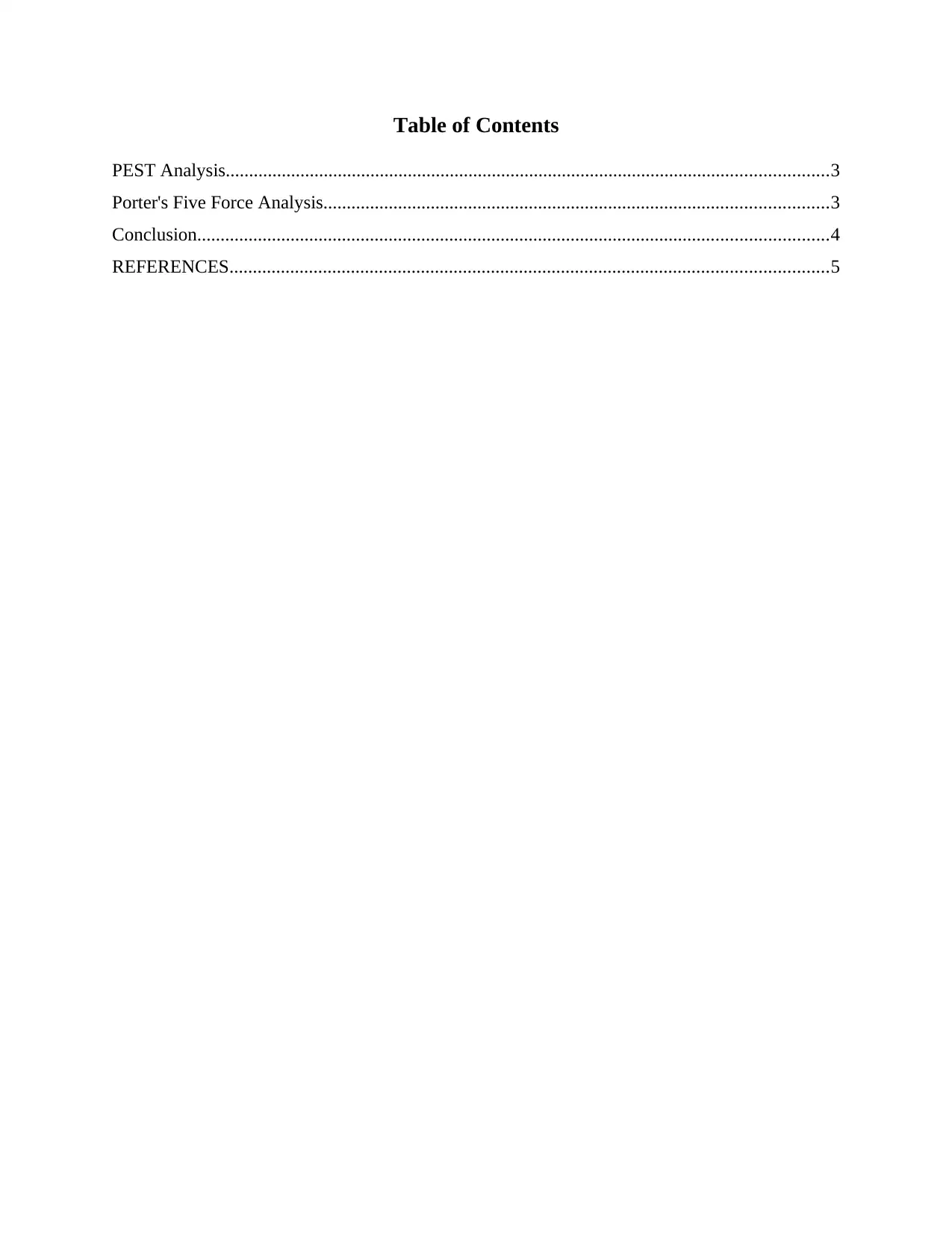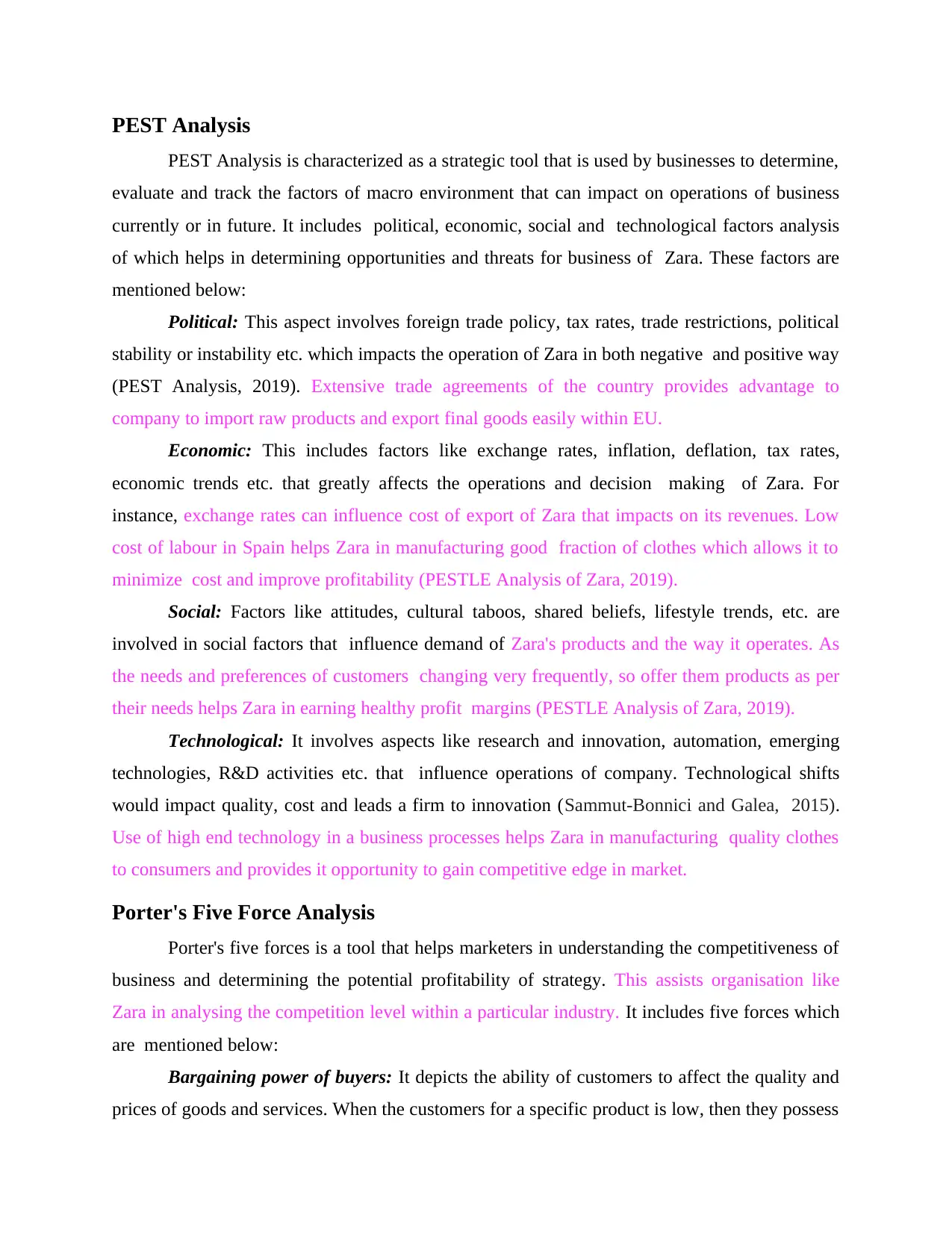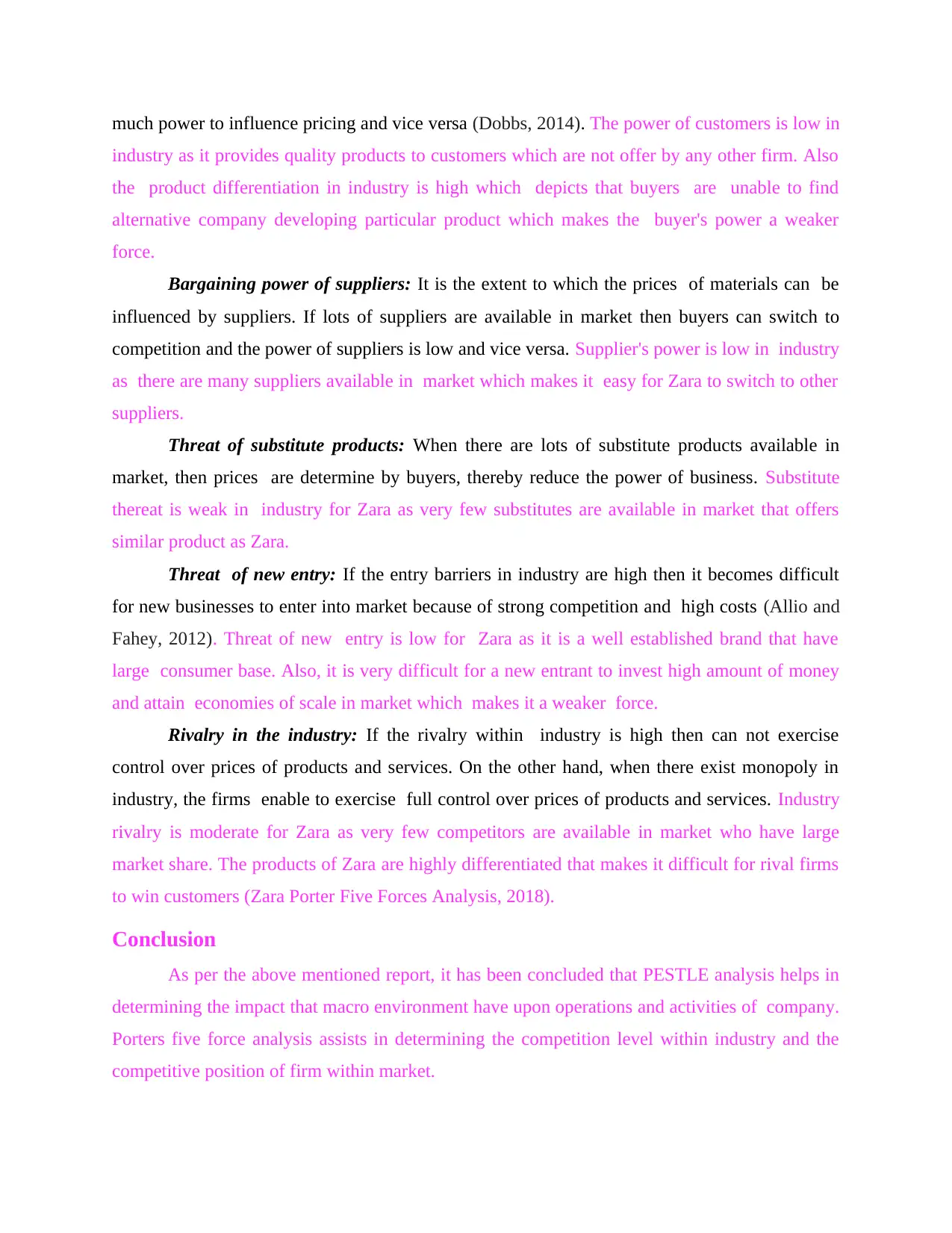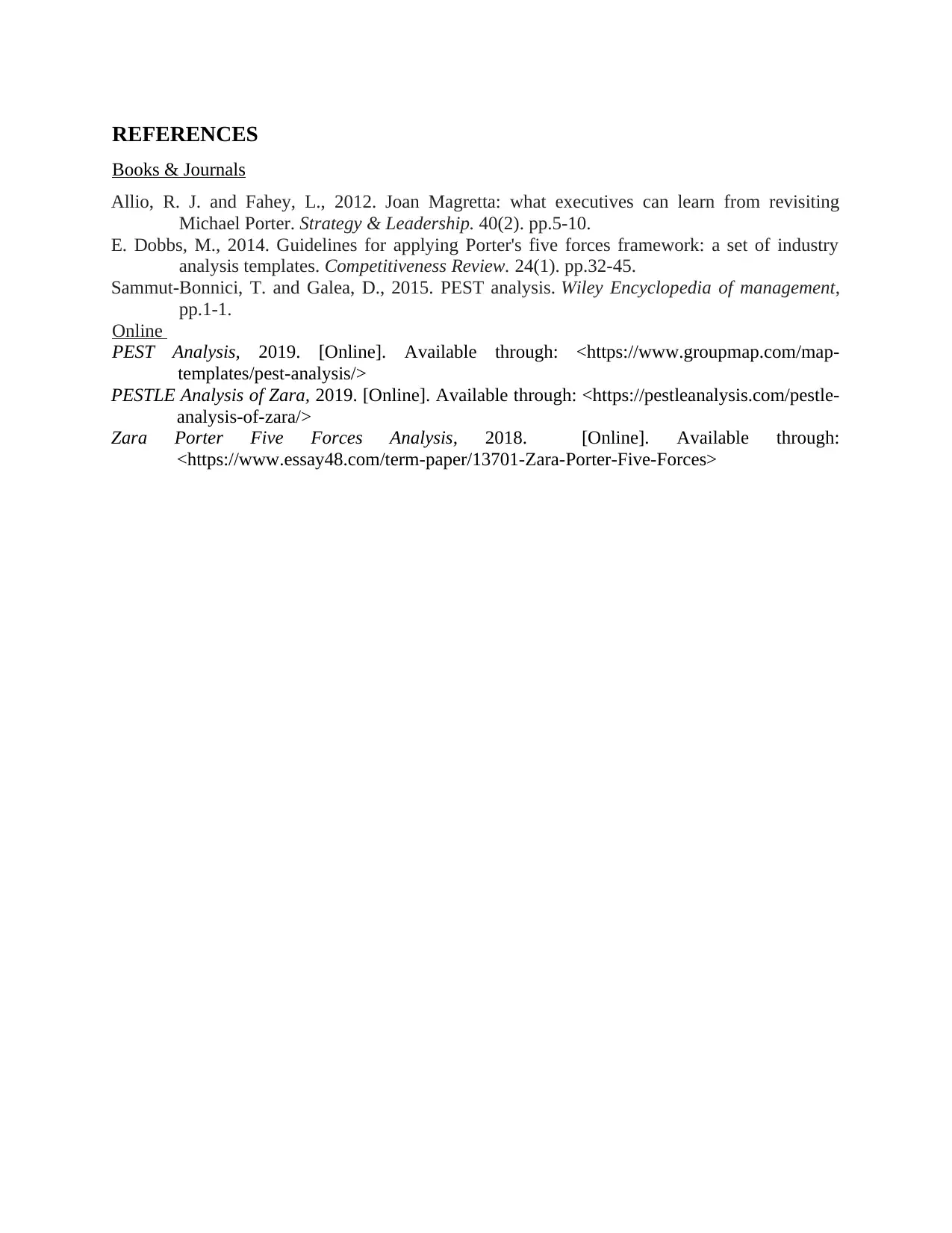Global Business Environment Portfolio Paper: Zara Analysis
VerifiedAdded on 2023/01/18
|5
|1052
|75
Report
AI Summary
This report provides a detailed analysis of Zara's global business environment. It begins with a PEST analysis, examining the political, economic, social, and technological factors influencing Zara's operations. The political factors include trade policies and political stability, while economic factors encompass exchange rates and labor costs. Social factors cover customer preferences, and technological factors include innovation and automation. Following the PEST analysis, the report applies Porter's Five Forces framework to assess the competitive landscape of the fashion industry. The analysis evaluates the bargaining power of buyers and suppliers, the threat of substitute products and new entrants, and the intensity of industry rivalry. The conclusion summarizes the key findings, emphasizing the importance of both PEST and Porter's Five Forces in understanding Zara's strategic position and the broader competitive dynamics within the fashion industry. The report references several academic sources to support its analysis.

Global Business Environment
Portfolio Paper
Portfolio Paper
Paraphrase This Document
Need a fresh take? Get an instant paraphrase of this document with our AI Paraphraser

Table of Contents
PEST Analysis.................................................................................................................................3
Porter's Five Force Analysis............................................................................................................3
Conclusion.......................................................................................................................................4
REFERENCES................................................................................................................................5
PEST Analysis.................................................................................................................................3
Porter's Five Force Analysis............................................................................................................3
Conclusion.......................................................................................................................................4
REFERENCES................................................................................................................................5

PEST Analysis
PEST Analysis is characterized as a strategic tool that is used by businesses to determine,
evaluate and track the factors of macro environment that can impact on operations of business
currently or in future. It includes political, economic, social and technological factors analysis
of which helps in determining opportunities and threats for business of Zara. These factors are
mentioned below:
Political: This aspect involves foreign trade policy, tax rates, trade restrictions, political
stability or instability etc. which impacts the operation of Zara in both negative and positive way
(PEST Analysis, 2019). Extensive trade agreements of the country provides advantage to
company to import raw products and export final goods easily within EU.
Economic: This includes factors like exchange rates, inflation, deflation, tax rates,
economic trends etc. that greatly affects the operations and decision making of Zara. For
instance, exchange rates can influence cost of export of Zara that impacts on its revenues. Low
cost of labour in Spain helps Zara in manufacturing good fraction of clothes which allows it to
minimize cost and improve profitability (PESTLE Analysis of Zara, 2019).
Social: Factors like attitudes, cultural taboos, shared beliefs, lifestyle trends, etc. are
involved in social factors that influence demand of Zara's products and the way it operates. As
the needs and preferences of customers changing very frequently, so offer them products as per
their needs helps Zara in earning healthy profit margins (PESTLE Analysis of Zara, 2019).
Technological: It involves aspects like research and innovation, automation, emerging
technologies, R&D activities etc. that influence operations of company. Technological shifts
would impact quality, cost and leads a firm to innovation (Sammut‐Bonnici and Galea, 2015).
Use of high end technology in a business processes helps Zara in manufacturing quality clothes
to consumers and provides it opportunity to gain competitive edge in market.
Porter's Five Force Analysis
Porter's five forces is a tool that helps marketers in understanding the competitiveness of
business and determining the potential profitability of strategy. This assists organisation like
Zara in analysing the competition level within a particular industry. It includes five forces which
are mentioned below:
Bargaining power of buyers: It depicts the ability of customers to affect the quality and
prices of goods and services. When the customers for a specific product is low, then they possess
PEST Analysis is characterized as a strategic tool that is used by businesses to determine,
evaluate and track the factors of macro environment that can impact on operations of business
currently or in future. It includes political, economic, social and technological factors analysis
of which helps in determining opportunities and threats for business of Zara. These factors are
mentioned below:
Political: This aspect involves foreign trade policy, tax rates, trade restrictions, political
stability or instability etc. which impacts the operation of Zara in both negative and positive way
(PEST Analysis, 2019). Extensive trade agreements of the country provides advantage to
company to import raw products and export final goods easily within EU.
Economic: This includes factors like exchange rates, inflation, deflation, tax rates,
economic trends etc. that greatly affects the operations and decision making of Zara. For
instance, exchange rates can influence cost of export of Zara that impacts on its revenues. Low
cost of labour in Spain helps Zara in manufacturing good fraction of clothes which allows it to
minimize cost and improve profitability (PESTLE Analysis of Zara, 2019).
Social: Factors like attitudes, cultural taboos, shared beliefs, lifestyle trends, etc. are
involved in social factors that influence demand of Zara's products and the way it operates. As
the needs and preferences of customers changing very frequently, so offer them products as per
their needs helps Zara in earning healthy profit margins (PESTLE Analysis of Zara, 2019).
Technological: It involves aspects like research and innovation, automation, emerging
technologies, R&D activities etc. that influence operations of company. Technological shifts
would impact quality, cost and leads a firm to innovation (Sammut‐Bonnici and Galea, 2015).
Use of high end technology in a business processes helps Zara in manufacturing quality clothes
to consumers and provides it opportunity to gain competitive edge in market.
Porter's Five Force Analysis
Porter's five forces is a tool that helps marketers in understanding the competitiveness of
business and determining the potential profitability of strategy. This assists organisation like
Zara in analysing the competition level within a particular industry. It includes five forces which
are mentioned below:
Bargaining power of buyers: It depicts the ability of customers to affect the quality and
prices of goods and services. When the customers for a specific product is low, then they possess
⊘ This is a preview!⊘
Do you want full access?
Subscribe today to unlock all pages.

Trusted by 1+ million students worldwide

much power to influence pricing and vice versa (Dobbs, 2014). The power of customers is low in
industry as it provides quality products to customers which are not offer by any other firm. Also
the product differentiation in industry is high which depicts that buyers are unable to find
alternative company developing particular product which makes the buyer's power a weaker
force.
Bargaining power of suppliers: It is the extent to which the prices of materials can be
influenced by suppliers. If lots of suppliers are available in market then buyers can switch to
competition and the power of suppliers is low and vice versa. Supplier's power is low in industry
as there are many suppliers available in market which makes it easy for Zara to switch to other
suppliers.
Threat of substitute products: When there are lots of substitute products available in
market, then prices are determine by buyers, thereby reduce the power of business. Substitute
thereat is weak in industry for Zara as very few substitutes are available in market that offers
similar product as Zara.
Threat of new entry: If the entry barriers in industry are high then it becomes difficult
for new businesses to enter into market because of strong competition and high costs (Allio and
Fahey, 2012). Threat of new entry is low for Zara as it is a well established brand that have
large consumer base. Also, it is very difficult for a new entrant to invest high amount of money
and attain economies of scale in market which makes it a weaker force.
Rivalry in the industry: If the rivalry within industry is high then can not exercise
control over prices of products and services. On the other hand, when there exist monopoly in
industry, the firms enable to exercise full control over prices of products and services. Industry
rivalry is moderate for Zara as very few competitors are available in market who have large
market share. The products of Zara are highly differentiated that makes it difficult for rival firms
to win customers (Zara Porter Five Forces Analysis, 2018).
Conclusion
As per the above mentioned report, it has been concluded that PESTLE analysis helps in
determining the impact that macro environment have upon operations and activities of company.
Porters five force analysis assists in determining the competition level within industry and the
competitive position of firm within market.
industry as it provides quality products to customers which are not offer by any other firm. Also
the product differentiation in industry is high which depicts that buyers are unable to find
alternative company developing particular product which makes the buyer's power a weaker
force.
Bargaining power of suppliers: It is the extent to which the prices of materials can be
influenced by suppliers. If lots of suppliers are available in market then buyers can switch to
competition and the power of suppliers is low and vice versa. Supplier's power is low in industry
as there are many suppliers available in market which makes it easy for Zara to switch to other
suppliers.
Threat of substitute products: When there are lots of substitute products available in
market, then prices are determine by buyers, thereby reduce the power of business. Substitute
thereat is weak in industry for Zara as very few substitutes are available in market that offers
similar product as Zara.
Threat of new entry: If the entry barriers in industry are high then it becomes difficult
for new businesses to enter into market because of strong competition and high costs (Allio and
Fahey, 2012). Threat of new entry is low for Zara as it is a well established brand that have
large consumer base. Also, it is very difficult for a new entrant to invest high amount of money
and attain economies of scale in market which makes it a weaker force.
Rivalry in the industry: If the rivalry within industry is high then can not exercise
control over prices of products and services. On the other hand, when there exist monopoly in
industry, the firms enable to exercise full control over prices of products and services. Industry
rivalry is moderate for Zara as very few competitors are available in market who have large
market share. The products of Zara are highly differentiated that makes it difficult for rival firms
to win customers (Zara Porter Five Forces Analysis, 2018).
Conclusion
As per the above mentioned report, it has been concluded that PESTLE analysis helps in
determining the impact that macro environment have upon operations and activities of company.
Porters five force analysis assists in determining the competition level within industry and the
competitive position of firm within market.
Paraphrase This Document
Need a fresh take? Get an instant paraphrase of this document with our AI Paraphraser

REFERENCES
Books & Journals
Allio, R. J. and Fahey, L., 2012. Joan Magretta: what executives can learn from revisiting
Michael Porter. Strategy & Leadership. 40(2). pp.5-10.
E. Dobbs, M., 2014. Guidelines for applying Porter's five forces framework: a set of industry
analysis templates. Competitiveness Review. 24(1). pp.32-45.
Sammut‐Bonnici, T. and Galea, D., 2015. PEST analysis. Wiley Encyclopedia of management,
pp.1-1.
Online
PEST Analysis, 2019. [Online]. Available through: <https://www.groupmap.com/map-
templates/pest-analysis/>
PESTLE Analysis of Zara, 2019. [Online]. Available through: <https://pestleanalysis.com/pestle-
analysis-of-zara/>
Zara Porter Five Forces Analysis, 2018. [Online]. Available through:
<https://www.essay48.com/term-paper/13701-Zara-Porter-Five-Forces>
Books & Journals
Allio, R. J. and Fahey, L., 2012. Joan Magretta: what executives can learn from revisiting
Michael Porter. Strategy & Leadership. 40(2). pp.5-10.
E. Dobbs, M., 2014. Guidelines for applying Porter's five forces framework: a set of industry
analysis templates. Competitiveness Review. 24(1). pp.32-45.
Sammut‐Bonnici, T. and Galea, D., 2015. PEST analysis. Wiley Encyclopedia of management,
pp.1-1.
Online
PEST Analysis, 2019. [Online]. Available through: <https://www.groupmap.com/map-
templates/pest-analysis/>
PESTLE Analysis of Zara, 2019. [Online]. Available through: <https://pestleanalysis.com/pestle-
analysis-of-zara/>
Zara Porter Five Forces Analysis, 2018. [Online]. Available through:
<https://www.essay48.com/term-paper/13701-Zara-Porter-Five-Forces>
1 out of 5
Related Documents
Your All-in-One AI-Powered Toolkit for Academic Success.
+13062052269
info@desklib.com
Available 24*7 on WhatsApp / Email
![[object Object]](/_next/static/media/star-bottom.7253800d.svg)
Unlock your academic potential
Copyright © 2020–2025 A2Z Services. All Rights Reserved. Developed and managed by ZUCOL.




